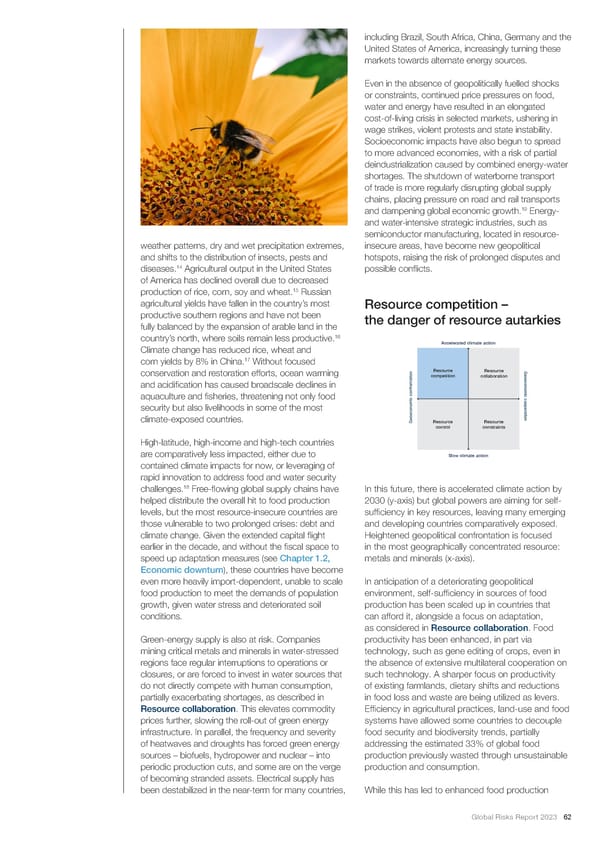including Brazil, South Africa, China, Germany and the United States of America, increasingly turning these markets towards alternate energy sources. Even in the absence of geopolitically fuelled shocks or constraints, continued price pressures on food, water and energy have resulted in an elongated cost-of-living crisis in selected markets, ushering in wage strikes, violent protests and state instability. Socioeconomic impacts have also begun to spread to more advanced economies, with a risk of partial deindustrialization caused by combined energy-water shortages. The shutdown of waterborne transport of trade is more regularly disrupting global supply chains, placing pressure on road and rail transports and dampening global economic growth.19 Energy- and water-intensive strategic industries, such as semiconductor manufacturing, located in resource- weather patterns, dry and wet precipitation extremes, insecure areas, have become new geopolitical and shifts to the distribution of insects, pests and hotspots, raising the risk of prolonged disputes and 14 diseases. Agricultural output in the United States possible con昀氀icts. of America has declined overall due to decreased 15 production of rice, corn, soy and wheat. Russian agricultural yields have fallen in the country’s most Resource competition – productive southern regions and have not been the danger of resource autarkies fully balanced by the expansion of arable land in the 16 country’s north, where soils remain less productive. Accelerated climate action Climate change has reduced rice, wheat and 17 corn yields by 8% in China. Without focused conservation and restoration efforts, ocean warming Resource Resource Geoeconomic cooperation competition collaboration and acidi昀椀cation has caused broadscale declines in ontation aquaculture and 昀椀sheries, threatening not only food security but also livelihoods in some of the most climate-exposed countries. Geoeconomic confrResourceResource control constraints High-latitude, high-income and high-tech countries are comparatively less impacted, either due to Slow climate action contained climate impacts for now, or leveraging of rapid innovation to address food and water security 18 challenges. Free-昀氀owing global supply chains have In this future, there is accelerated climate action by helped distribute the overall hit to food production 2030 (y-axis) but global powers are aiming for self- levels, but the most resource-insecure countries are suf昀椀ciency in key resources, leaving many emerging those vulnerable to two prolonged crises: debt and and developing countries comparatively exposed. climate change. Given the extended capital 昀氀ight Heightened geopolitical confrontation is focused earlier in the decade, and without the 昀椀scal space to in the most geographically concentrated resource: speed up adaptation measures (see Chapter 1.2, metals and minerals (x-axis). Economic downturn), these countries have become even more heavily import-dependent, unable to scale In anticipation of a deteriorating geopolitical food production to meet the demands of population environment, self-suf昀椀ciency in sources of food growth, given water stress and deteriorated soil production has been scaled up in countries that conditions. can afford it, alongside a focus on adaptation, as considered in Resource collaboration. Food Green-energy supply is also at risk. Companies productivity has been enhanced, in part via mining critical metals and minerals in water-stressed technology, such as gene editing of crops, even in regions face regular interruptions to operations or the absence of extensive multilateral cooperation on closures, or are forced to invest in water sources that such technology. A sharper focus on productivity do not directly compete with human consumption, of existing farmlands, dietary shifts and reductions partially exacerbating shortages, as described in in food loss and waste are being utilized as levers. Resource collaboration. This elevates commodity Ef昀椀ciency in agricultural practices, land-use and food prices further, slowing the roll-out of green energy systems have allowed some countries to decouple infrastructure. In parallel, the frequency and severity food security and biodiversity trends, partially of heatwaves and droughts has forced green energy addressing the estimated 33% of global food sources – biofuels, hydropower and nuclear – into production previously wasted through unsustainable periodic production cuts, and some are on the verge production and consumption. of becoming stranded assets. Electrical supply has been destabilized in the near-term for many countries, While this has led to enhanced food production Global Risks Report 2023 62
 2023 | Global Risks Report Page 61 Page 63
2023 | Global Risks Report Page 61 Page 63